
















The Farming Families is distributed free exclusively to the farmers, ranchers and producers in rural Sioux, Plymouth and Lyon Counties. All rights reserved. Content in this magazine should not be copied in any way without the written permission of the publisher. The Farming Families assumes no responsibility for unsolicited manuscripts or photographs. Content in articles, editorial
advertisements are not necessarily endorsed by The
From birthcare to urgent care ... pediatrics to geriatrics ... screenings to surgeries … we offer the right care at the right place at the right time.

Orange City Family Medicine:712-737-2000
Orange City Family Medicine: 712-737-2000


Hospers MedicalClinic:712-752-8800
Hospers Medical Clinic: 712-752-8800
MillCreek Family Practice:712-448-2000
Mill Creek Family Practice: 712-448-2000
Orange City Walk-In Clinic:712-707-6070
Orange City Walk-In Clinic: 712-707-6070
Hospital/Emergency Room:712-737-4984
Hospital/Emergency Room: 712-737-4984
Safe family medicine clinics in three communities, plus Walk-In Clinic and Emergency Medicine in Orange City.

Skilled family doctors, nurses, surgeons, therapists, urgent care and emergency medicine providers, and support staff.
Essential health and well-being services, screenings, and medical care for every stage of life ... every day.
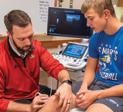
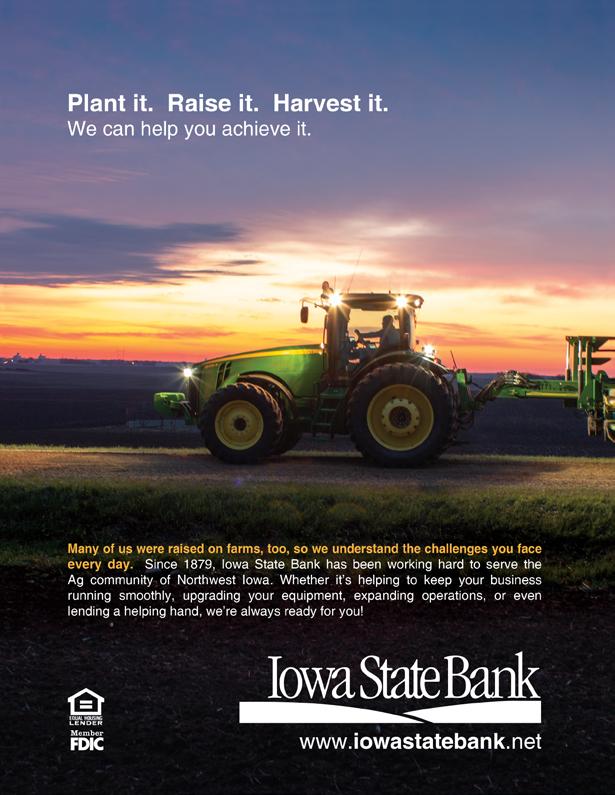
 By Bob Fitch
By Bob Fitch
Eugene Ellensohn immigrated to the United States from Germany in 1922. He had a job lined up on a farm east of Le Mars that paid him $1 a day. Later he worked in North Dakota’s potato fields and at a Chicago packing plant. He returned to Plymouth County and married a local girl in 1928. They started farming in 1929.
Eugene’s grandson, Gary Ellensohn, said when the farm economy collapsed his grandparents owned 10 pigs. “They sold those pigs to pay the rent. All they had left was chickens. So they ate eggs every day for an entire winter. As an immigrant, Grandpa couldn't borrow any money. If you didn't have the cash to buy something, you were out of luck. They wouldn’t loan an immigrant a nickel.”
There was a different problem for beginning farmers 50 years later. In the early days of Gary’s farming career, the banks would loan him money – at an interest rate of 21 percent. “When I started farming in 1979, I rented a quarter section of ground and had two sows. That's how I started and worked up
from there to about 150 sows when we were in the breeding stock business.” He switched to custom feeding hogs in 1994. Complications after knee surgery pushed him out of livestock at the end of 2019. He’s also been selling federal crop insurance since 1999.

Gary married Mary Reuter of Le Mars in 1980 and they moved onto the home place in 1983. They purchased their first 40 acres in 1985. “The first piece of ground I bought was $1,100 an acre. That was right after the big crash when land had been up to $3,000 an acre.”
He remembers his grandfather telling him that, from World War II until around 1977, land prices didn’t fluctuate much more than $50 an acre. “The fall before Dad moved here in 1964, Grandpa bought an 80 and Dad bought an 80 and they gave $550 an acre for it.”



It’s a long ways from $550 an acre back then to today’s going rate in the neighborhood of $20,000 an acre. The scale of that investment is the challenge for young farmers such as Gary’s son, Todd, and his wife, Lori. Mary said, “Almost the only way you're going to be able to farm today is to start with your parents.” Gary said, “Somebody has to have an off-farm job, and maybe both of them do to make it work. It’s a tough game. I don't care if you’re in livestock or just have a grain farm, it's a tough go. Without supplemental income, it's just tough to make it work.”

Todd has been with Syngenta Crop Protection as a chemical sales representative for northwest Iowa for 10 years, after starting as a retail agronomist at Remsen Farmers Coop. Lori got her start in the feed division at Remsen Coop. Now she’s worked for livestock nutrition company Furst McNess for eight years. She started in sales support and technical service and was promoted to be the company’s marketing manager last year. In May, Gary and Mary moved to a new home in Le Mars, while Todd, Lori and their four children moved to the Ellensohn home place. According to Todd, “Since we both grew up on farms, we wanted our kids to have the same sort of experience.” Lori grew up on a diversified grain and livestock farm at Knoxville in south central Iowa. The couple met when they were both students at Iowa State University. Todd majored in


Northwest Bank your first call for financial products and services for all things agriculture. If it’s part of a farm, an acreage or anything outside the city limits, we can help with financing and expertise.

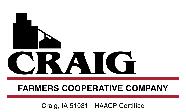
agronomy with a minor in international studies. Lori majored in animal science.
Lori said, “Our first date was moving hogs.” Todd said, “And our second date was power washing.” Gary joked, “He wouldn't power wash two feet or load one pig for me, but he’d go down there and help her.” The couple got married in 2011.
Moving back to this area allowed Todd to play a role on the farm, with the hope that someday he can take the reins of the corn and soybean operation.




Todd and Lori’s children are Hadley, 11; Marcus, 9; McKenna, 7; and Damien, 5. They’re active in various sports and their parents help out coaching. They are also fans of Outlaw Series racing.
This was Hadley’s first year in 4-H, but all four have experience showing hogs in open shows.











McKenna made sure to inform this writer that she placed higher at this summer’s Iowa State Fair than Marcus did. Todd and Lori raised show pigs for the first 10 years of their marriage, but their kids are showing purchased 4-H pigs now.
Hadley, Marcus, McKenna and Damien attend Gehlen Catholic School where their dad is president of the school board. They are the fifth generation of the family enrolled at Gehlen, which was originally known as St. Joseph’s Catholic School. According to Gary, “When my grandma went to St. Joe's in the early 1900s, they actually boarded at the school in the attic upstairs for the entire week and only went home on the weekends.”
Gary (class of ’76) and Mary (class of ’78) met at Gehlen. All four of their kids attended the school. Their other children are:

• Son Aaron lives in Gilbert, Iowa, and works for the state of Iowa’s Weight & Measures Bureau. He and his wife, Jessica, have five children.
• Son Kyle lives in Urbandale and is a chiropractor. He and his wife, Katrina, have two children.
• Daughter Krista lives in Chicago where she is the manager of training operations at Hubbard Street Dance Studio, plus belongs to a professional hip hop dance company called Boom Crack.
Aaron and Kyle often come home to help during harvest. Mary said she’s the grain cart driver “of last resort.” But Gary and Todd wouldn’t let her underplay her role on the farm. In addition to driving grain cart, she goes after seed and parts in the spring, brings water for the sprayer, helps move equipment from field to field and brings the crew lunch during planting and harvest.


One of the most groundbreaking inventions by an Iowan was the gasoline-powered tractor which was patented in 1892 by feed mill operator John Froelich of Clayton County. His Waterloo Gasoline Traction Engine Company eventually became John Deere Tractor Works. It was the beginning of an unprecedented transformation of the primary power source in soil preparation, planting and harvesting.


The movement of power from horses and mules to fossil-fuelpowered tractors was a remarkable leap forward in farming. On a smaller scale, farmers have always toyed and tinkered using their hands-on knowledge and practical skills to create a wide variety of engineering and science-based inventions. Farmers’ desire to improve efficiencies as a method of sustaining the viability of their farms was a large part of the Second Industrial Revolution, also known as the Golden Age of Invention, lasting from about 1870 to 1914. Other scholars identify the era as lasting until 1940.
During this era, inventions were produced at 10 times the rate of the previous 70 years, helping make the United States an innovation powerhouse and world leader in technology. Innovative thinking and inventing, supported by a robust patent system, helped the U.S.
become the cultural and commercial power that it is today.


From 1880 to 1939, at least 190 patents were issued to Sioux County residents. Inventions ranged from a paring knife, rail crossing signal, cigar rest and envelope moistener to a voting machine, lace curtain stretcher, violin tail piece and fly trap. Hawarden and Calliope accounted for the most patents,
with 58 in those years. The first patent issued to a Sioux County inventor appears to be for a grate bar for fire engines (Robert Rose, Calliope, 1880). Inventors with the most patents were:
• Joseph Eulberg of Alton. Horse collar (1906); wheel and demount able rim (1916); and exhaust heater for vehicles (1926).
• Frank L. Doty of Calliope. Hay loader/stacker and rope clamp (1903) and apparatus for loading and hay stacker (1904).
In 1916, Johannes Nielsen, Chatsworth, patented improvements to a corn-harrow. Partial description: “The principle object of the invention is to improve and simplify the general construction of devices of this character. A further object of the invention is to provide an improved form of frame for carrying the harrow teeth.”

In 1915, Sigurd B. Christensen, Granville, patented improvements to planters. Partial description: “One object of the present invention is to improve the construction of the marker so that it may ride over stones or other unyielding obstructions encountered over the field.”
• Joseph H. Oberman of Granville. Three patents for pumps and one for a pump operating mechanism in 1924.
• Luther T. Kenny of Hawarden. Molding machine (1912); concrete molding machine (1914); fastener for sliding doors (1917); and swinging car door and hanger (1918).
• Charles L. Dyk of Orange City. Two patents for manure spreaders in 1908 and one in 1912.
• Arie Kleinhesslink of Orange City. Bracket for current conducting wires (1912); binding post (1924); and tent stake (1925).
• Lammert Van Olst of Orange City. Gate latch mechanism (1898); churn and rocking churn (1903).
• John Huizenga of Rock Valley. Protectograph in 1908 and patents for check protectors in 1915 and 1923.
• Frank Vogelzang of Rock Valley. Device or tool for tightening fence wires (1904); liquid fuel lock device (1919); flying machine (1920); and dental instrument (1921).
The vast majority of the patented inventions or product improvements from Sioux County were for agricultural machinery and tools. The list of ag-related patents in this era touched on every area of farming: Stock watering trough, hog oiler, windmill, seed corn tester, manure hook, wire stretcher, egg separator, corn planter, disk sharpener, hog holder, tank heater, and many more. Example schematics from patent applications for a few of these inventions are pictured here.
From the late 1800s to World War II, American farmers battled locusts and drought and high rail costs and a tight money supply and many other challenges. Necessity was truly the mother of invention. Even with the deck often stacked against them, their tenacity and creative minds provided a path to survival and an example to future generations.
When the United States was founded, 90 percent of the population was engaged in farming or a related field. Today, less than 2 percent of the population feeds the other 98 percent – an impossible feat without mechanization and technological advancements.
Editor’s note
For a list of other inventions patented by Sioux County residents between 1880-1939, see the iagen.web.org link in the source list below. Copy the patent number and paste into the Patent Public Search Site link listed below. For patent numbers of less than 7 digits, add a “0” at the beginning.

Sources
• www.iagenweb.org/sioux/invent.htm
• Patent Public Search. bit.ly/3soJJLX
• USDA Economic Research Service. bit.ly/45qMxqD
In 1913, Luther T. Kenny, Hawarden, invented and patented improvements in concrete molding machines. Partial text description: “The primary object of this invention is to provide a machine for the rapid and economical manufacture of cement or concrete blocks used in the construction of silos, cisterns, water tanks, etc. Figure 1 (embodies) my improvements, the top of the mold box swung open.”

• Senator Charles Grassley. bit.ly/47ZDajo Wikipedia. bit.ly/3swL4R6, bit.ly/3YQG0mp
• Oklahoma AIC. bit.ly/3PbP421
• Students of History. bit.ly/3EaGQBd
• The Rise and Fall of American Growth. bit.ly/3KWoXKb
• The Brookings Institution. bit.ly/45HqtHZ
• Harvard Business Review. bit.ly/3svsVD5
• History.com. bit.ly/3swLFSQ Science History Institute. bit.ly/3KYLDcG
• Iowa PBS. bit.ly/45I63hP
In 1914, Burton Walrath, Rock Valley, invented and patented improvements to the gear-shifting mechanism of motor-driven vehicles. Partial description: “(The) object is the production of improved means whereby a gear may be selected while another gear is in operative relation with the main shaft and the former subsequently placed in operative position.”


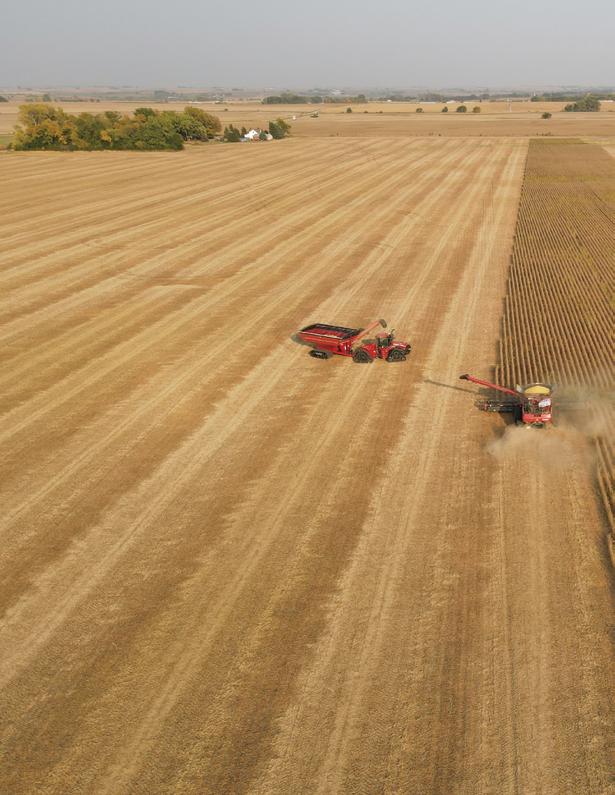
 SOYBEAN HARVEST
PHOTO BY JON KLEMME
SOYBEAN HARVEST
PHOTO BY JON KLEMME
Horses and good ol’ fashioned horse sense never go out of style at the Terry and Sherry Bolding farm and ranch near the western border of Lyon County.
“Both of us have always been around horses,” Terry said. Both of Sherry’s grandfathers were among the last in the area to farm with horses. “They loved their teams and Grandpa George liked to ride, too,” she said. “I’ve always loved horses. My folks got me started riding when I was three … they threw me on a horse and I was on top of the world.”
Her parents farmed about a mile out of Larchwood, while Terry’s parents farmed in Centennial
Township on the homesite where the couple lives today. He said, “My parents were older when they adopted me. My mom and her family moved here from White River, South Dakota, with a team of horses and a covered wagon. There were cars then, but they didn’t have one.” Both of their mothers were hands-on, working in the field.
Terry and Sherry own 100 head of commercial stock cows plus have traditional crop ground. But their

passion is breeding and selling Black Overo horses. Their breeding stock and a portion of the offspring are registered with the American Paint Horse Association.
According to Sherry, “Before we were even married, we were buying young horses, growing them up. I’d break them to ride and resell them.” In 1989, a friend asked if they were interested in purchasing a stallion. “We knew having a stallion and buying mares would change our life. Every day I looked
at that picture of Stormy (King Stormy McCue) and we debated for about six months. We finally ended up buying him when he was three years old.” Sherry took a short course at Colorado State University on equine artificial insemination techniques. The couple started breeding mares and eventually the stallion sired about 200 registered foals, plus many non-registered foals.
Their next stallion was Maxdee Blue, an own son of Blue Max, a legendary horse in the Paint business that sired many champions and point earners. Maxdee Blue just died on September 1st at the age of 23. Their current stallion is Rocket Two Freedom, another Black Overo.

Providing Feed and Vet Supplies for over 30 years. We also provide consulting services for feedlot cattle and cow calf pairs.

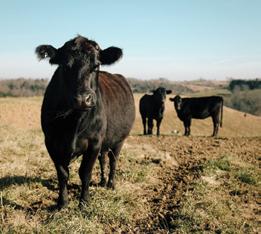
Terry said there’s always been a strong market for Black Overo horses. The multi-colored ones are valued in the show ring and simply for their good looks. The solid-colored offspring are a favorite of cowboys because the horses are big and good for roping. Regardless of color, the Bolding’s Black Overo horses are known for good conformation, substance, hooves and bone, and a pretty head. Sherry said, “We've always focused on the conformation of our horses, the build, the structure. It's not enough just to have the bloodlines you want. Form to function is everything. That includes a good mind.”



How does a horse have a good mind? “Well, there's horses that will be rotten cheats, just like some people. They’re outlaws. It happens. A good honest horse will be your partner and your friend, and you'll work together as a team,” she said. Terry added, “There's some horses out there that you'll never ride. There’s some that are tough to break, tough to get along with, and you can never trust them.” The tough-to-get-along-with horses might end up as a cowboy’s horse. Because a cowboy’s horse often is ridden from sunup to sundown, the tough ones can become better after a lot of miles. “But for the average person that just wants to throw a leg over a horse once or twice a week, they sure don't need that kind of horse. So that's why the good, trainable mind is so important, along with good conformation, so that they stay sound into their later years of life,” Sherry said.
Another intangible that only a long-time horseman or horsewoman can identify: “You probably can't believe it, but you can tell a lot by the horse’s eye. If they're really quiet and mellow, you can see it in their eyes,” Terry said. “You learn more by actually working with the horses than you ever will out of a book or anything else.”

1 i n 8 w o m e n a n d 1 i n 8 3 3 m e n w i l l b e d i a g n o s e d w i t h b r e a s t
c a n c e r t h i s y e a r . T a l k t o y o u r d o c t o r a b o u t g e t t i n g c h e c k e d
E a r l y d e t e c t i o n c a n s a v e l i v e s .
The couple still rides horses to sort their cattle. They have three Border Collies who help with the sorting. “We’ve had a lot of good dogs over the years. Good Border Collies will go out with you in the winter weather or the rain, even when the cows aren’t friendly,” said Terry.

Married now for 41 years, he said people used to ask him why they didn’t have any children. “I’d tell them, ‘Every time she thinks about having a kid, I just buy her another horse.’”
They enjoy trail riding in their pastures, including some areas heavily wooded with oak trees. They also enjoy trail riding in the Black Hills where they’ve ridden the entire Centennial Trail, which is 111 miles from Bear Butte to Wind Cave. Sherry said, “Terry never gets lost when we’re riding. I don't know how he does it. I can get lost wherever I go.” He added, “I probably won’t take you back the same way. I don't really backtrack anywhere, I like to make big circles, but I’ll get you back to the spot.”
Right now, Boldings have about 35 head of horses, which is down from their peak of 75 head. “Getting older, we’ve kind of backed down a little,” he said. “Everybody thinks we should quit, but I really don't want to. The money isn’t really part of it – I just want something to do. There's nothing more fun than to go out to the barn and see a new baby colt or a new baby calf born. I mean, that puts a smile on your face. No matter how bad the day was, when you see that, you kind of liven up and it makes you feel good again.”





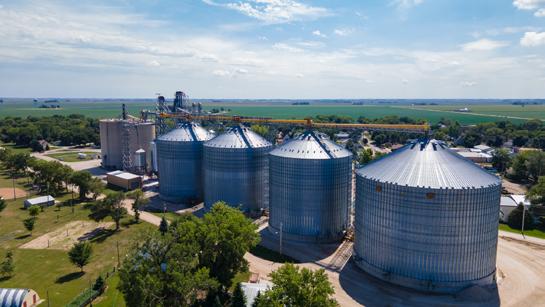


The Kooima family operates Pumpkins on Garfield, a farm selling pumpkins, gourds, broom corn, Indian corn, corn stalks, peppers, onions, potatoes, green beans, cabbage, cauliflower and tomatoes. Ingredients to make homemade salsa are a specialty. Customers can pick their own pumpkin straight out of the patch or choose from about 1,000 displayed inside. There are about 100 varieties available.
Their 10-acre corn maze is a centerpiece to a lot of the fun. Visitors search for 10 stations and a special hidden object. The hidden object has included everything from a pair of cement legs sticking out of the ground and a toilet filled with cement to a boat and Minions.

The maze has three difficulty levels. The easiest takes about 40 minutes, medium is an hour, and the hardest is one-and-a-half hours.
Some groups tackle the maze in the dark with flashlights, followed by a bonfire.
There’s a pumpkin weight-guessing contest – if you guess right, you get to take the pumpkin home (even if you don’t really want a 90-pound pumpkin!). This will be the fourth year the Kooimas have had a family contest to raise the biggest pumpkin.
“We have some Facebook fans who really enjoy the big reveal I do week-





by-week,” Mark said. So far, the biggest pumpkin has been 190 pounds.

Before the fun begins, there’s a lot of work. Mark and Nancy’s children are the planting, weeding and harvesting crew. “We've got five kids and they've been pretty instrumental in this whole deal. They put in a lot of work through the summers,” Mark said. Their children are:

• Connor, 21, a senior at Dordt University, working on a degree in agricultural plant science.



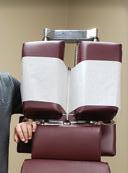
• Ethan, 19, a sophomore at Dordt, double majoring in finance and marketing, with a minor in accounting.

• Gracia, 16, a junior at Trinity Christian High School in Hull.
• Jolie, 13, an eighth grader.
• Troy, 8, a third grader. Both Jolie and Troy attend Protestant Reformed Christian School in Hull.

In addition to growing pumpkins and gourds for sales in the fall, the family grows and sells sweet corn and produce in Rock Valley and Sioux Center in July and August. According to Mark, “Spring is busy because we're getting basically everything set up, whether it's a sweet corn patch, a pumpkin patch, or the three large gardens back there. It's a constant battle keeping the weeds out. If we’re going to take a family vacation, that happens in June, the only time we’re not totally tied down.” From mid-July to the end of August, the Kooima kids are up around 5:30 a.m. to pick corn and then get to Sioux Center and Rock Valley early to begin sales.
In a way, the family inherited the 30-year sweet corn business of Nancy’s family and the hobby sales done by Mark’s nephews and nieces. “In the end, we’re selling ‘Kooima Corn’ in Rock Valley and selling both ‘Kooima Corn’ and ‘Bleyenberg Corn’ in Sioux Center. We still get a few checks made out to Bleyenberg


Sweet Corn every year,” he said. Over the years, they added produce to their sales and have a loyal following in both towns. “Our kids always get a kick out of seeing our regular customers every year. And the regulars love talking to the kids,” she said.


Nancy is the daughter of Alvin and Betty Bleyenberg, who farmed west of Sioux Center. She was the tenth of 15 children. “We grew up raising broilers – I can hardly eat chicken to this day.” A big part of being a Bleyenberg was selling sweet corn adjacent to Central Park in Sioux Center. Sweet corn sales helped the family pay tuition at Christian schools. In fact, all of the Bleyenberg children had to pay their individual tuition during their senior year at Western Christian.
Mark grew up on the farm of his parents, Tim and the late Clarine Kooima, who had four sons and two daughters. “My mom passed away a year ago in August. She instilled in me a love for all things gardening. I helped her care for a large garden growing up. Dad enjoys driving behind the shed and checking everything out almost weekly and visiting with us when he catches us in the pumpkin or sweet corn patch.” Mark’s brothers, Steve and Kevin, operate the family farm today. The next generation is also coming on. Steve lives on the original home site, which is adjacent to Pumpkins on Garfield; and Kevin lives a mile north.
Both Mark and Nancy attended Protestant Reformed Christian School in Hull and graduated from Western Christian High School. After high school, she worked a variety of jobs. Mark has a degree in agricultural business from Dordt University. During college, he interned at Farmers Elevator in Doon and then worked there for 20 years, starting as an agronomist and applicator.
Mark and Nancy married in 2001. They lived in Hull for about five years before moving to their current home in 2008 when his parents moved to town. In 2019, Mark went into a partnership with Theo Bartman of Rock Valley to own and operate Precision Ag & Seed, building on the Pioneer dealership previously owned by Elmer Boon. “Theo and I have a good give and take. He farms with his dad and does some custom spraying. There are times when he's pretty tied up and other times I'm pretty tied up with this.”


When the family still lived in Hull, they started growing pumpkins in the corner of a 20-acre field Mark had farmed for many years. The large, pie-type pumpkins were sold to local grocery stores. “I've always enjoyed gardening. Even as a kid I was growing pumpkins.”

After they moved to the acreage on Garfield Avenue, they first sold pumpkins at the end of their driveway right from the back of a hay rack. Twelve years ago, they ratcheted up the scale of the operation, building the shed from which they operate now. The corn maze started the next year when Mark was able to plot the layout via GPS. After the corn comes up, he begins to mow the trail (which takes about four hours). Next year, he’s hoping to save a lot of repeated mowing by plotting the layout right into his brother’s corn planter.
When the summer sweet corn sales end, the family has only about two weeks before diving into pumpkin sales, which begins the weekend after Labor Day. “Before opening, we do a massive cleaning of the shed. It’s a big job to turn the shed into a retail space for two months and get the corn maze set up,” he said.



While Mark and Nancy’s family is working through their busy season, they count on family members to keep the fun rolling along. His brother, Glen, his wife, Kris, and her sister Stacy, pull a prank on them every year. “One year, when we were still selling from the driveway, they stacked all the pumpkins by our front door so when we opened it, all the pumpkins fell in. Then they wrote ‘We were here’ with gourds on the driveway,” said Nancy.
“Another time they came on a Saturday night. The next morning, we went outside and they had every picnic table turned upside down; they had pumpkins on our roof; and they had put pumpkins in the portapotty,” she said.
The Hull address of Pumpkins on Garfield is 2846 Garfield Avenue (three miles south of Doon).

Hours are Monday through Saturday from 10 a.m.-9 p.m. through October 31st.








Serving farmers in southeast SD and northwest IA

SEMI and AG TIRES (new and used) MOBILE TIRE REPAIR AND SERVICE

712-753-4800
2403 US Highway 18 Inwood IA 51240
www.oak-street-station.com
From tasteofhome.com
INGREDIENTS:
1/2 cup butter, softened
2 cups sugar
1/2 teaspoon vanilla extract
2 large eggs, room temperature
2 cups all-purpose flour
1-1/2 teaspoons ground cinnamon
1 teaspoon ground nutmeg
1/2 teaspoon salt
1/2 teaspoon baking soda
6 cups chopped peeled tart apples
BUTTERSCOTCH SAUCE:

1/2 cup packed brown sugar
1/4 cup butter, cubed
1/2 cup heavy whipping cream
DIRECTIONS:
1. In a large bowl, cream the butter, sugar and vanilla. Add eggs, 1 at a time, beating well after each addition. Combine the flour, cinnamon, nutmeg, salt and baking soda; gradually add to creamed mixture and mix well (batter will be stiff). Stir in apples until well combined.
2. Spread into a greased 13x9-in. baking dish. Bake at 350° for 40-45 minutes or until top is lightly browned and springs back when lightly touched. Cool for 30 minutes before serving.
3. Meanwhile, in a small saucepan, combine brown sugar and butter. Cook over medium heat until butter is melted. Gradually add cream. Bring to a slow boil over medium heat, stirring constantly. Remove from the heat. Serve with cake.




